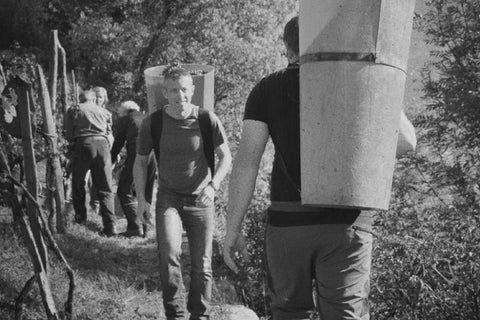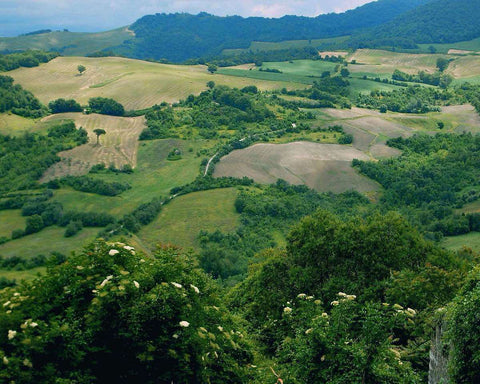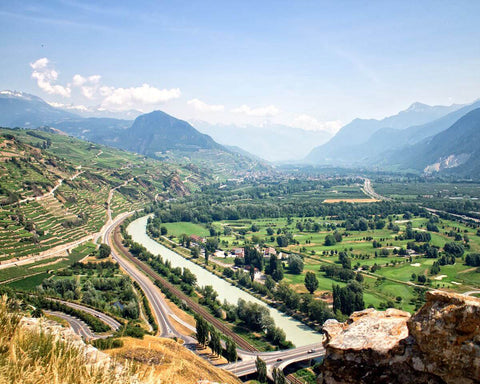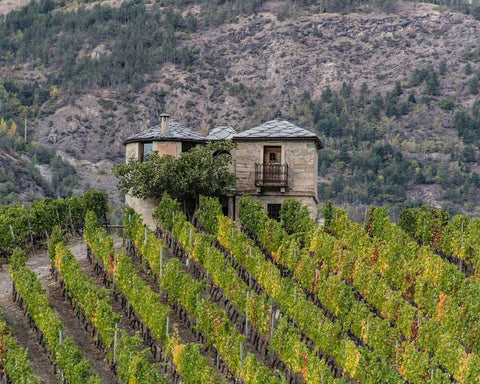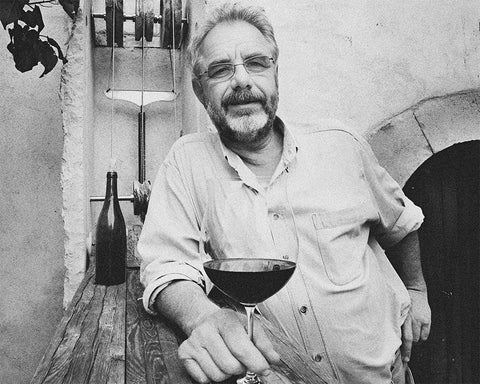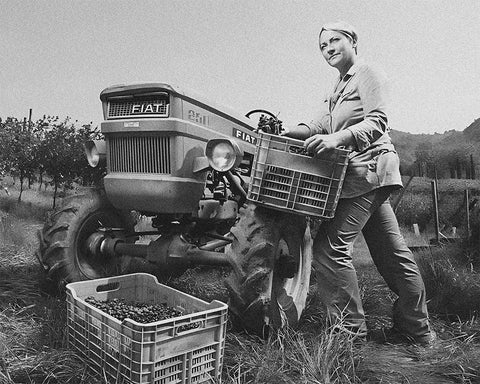Introduction and Overview
Valtellina stands as Italy's northernmost Nebbiolo-producing region. This Alpine wine region occupies a unique position in the global wine landscape. The valley produces some of the world's most distinctive expressions of Nebbiolo, known locally as Chiavennasca.
The region sits in Lombardy's Alpine valley near the Swiss border. Ancient glaciers carved this dramatic landscape over millennia. Today, south-facing slopes rise steeply from the valley floor, creating ideal conditions for heroic viticulture.
Leonardo da Vinci described Valtellina as "a valley surrounded by high mountains that makes strong wine." This Renaissance observation captures the region's essence perfectly.
Valtellina matters because it represents heroic viticulture at its finest. The extreme conditions create wines with unique terroir expression. These wines offer alternatives to more famous Nebbiolo regions while maintaining their own distinct character.
Geographic and Geological Foundation
Physical Geography
Valtellina stretches through the Rhaetian Alps in northern Lombardy. The valley extends 45 kilometers along the Adda River from Morbegno to Tirano. This east-west orientation creates perfect south-facing exposure for vineyards.
Altitude ranges from 230 to 800 meters above sea level. The vineyards occupy steep slopes on the Rhaetian mountainside. These elevations provide crucial temperature variation between day and night.
Key Geographic Facts:
• Valley length: 45 kilometers
• Elevation range: 230-800 meters
• Primary river: Adda
• Mountain range: Rhaetian Alps
The south-facing slopes maximize sunlight exposure throughout the growing season. Mountain peaks provide protection from harsh northern winds. This natural amphitheater creates ideal microclimates for grape growing.
Geological Terroir
Ancient glaciers carved Valtellina's valley 10,000 years ago. These glacial movements created the dramatic landscape we see today. The geological foundation directly influences wine character and quality.
Soil composition features alluvial, gravelly, well-drained earth rich in silica. Stone-littered vineyards absorb heat during the day and release it at night. This thermal regulation helps ripen grapes in the challenging Alpine climate.
Granite, gneiss, and quartz dominate the mineral content. These hard rocks create poor, well-draining soils that stress vines beneficially. The mineral composition contributes distinctive characteristics to the wines.
Dry-stone wall terracing dates from the 10th to 14th centuries. These ancient walls, called muretti, support steep vineyard slopes. The stone construction allows drainage while preventing erosion on extreme gradients.
Climate and Microclimate
Alpine continental climate defines Valtellina's growing conditions. Cool nights preserve acidity in grapes while warm days promote ripening. This diurnal temperature variation is crucial for quality wine production.
South-facing exposure maximizes sunlight throughout the growing season. The orientation allows even late-ripening Nebbiolo to achieve full maturity. Mountain peaks shield vineyards from harsh winds and weather.
Lake Como influences eastern zones of the valley. The lake moderates temperature extremes and provides humidity regulation. Cool alpine breezes and thermal air currents create complex microclimates within individual vineyards.
Historical Development
Ancient Origins
Roman Empire viticulture established Valtellina's wine tradition. Virgil and Pliny referenced the region's wines in their writings. These ancient sources document quality wine production over two millennia ago.
Pre-Roman cultivation began with Ligurians and Etruscans. These early peoples recognized the valley's potential for grape growing. Archaeological evidence suggests continuous winemaking for over 2000 years.
This continuous tradition makes Valtellina one of Europe's oldest wine regions. The unbroken chain of knowledge passes from generation to generation. Modern producers still use techniques refined over centuries.
Medieval and Renaissance Expansion
Monastic communities developed much of Valtellina's viticulture during the medieval period. Religious orders had resources and dedication needed for terracing construction. They established many vineyards that continue producing today.
Peak expansion occurred in the mid-19th century with over 6,000 hectares under vine. This period saw maximum development of the terraced landscape. Economic prosperity supported extensive vineyard construction and maintenance.
Historic terracing construction required enormous labor investment. Workers moved tons of stone to build supporting walls. This infrastructure created the foundation for modern Valtellina viticulture.
Modern Era and Recognition
DOC status came to Valtellina in 1968. This recognition acknowledged the region's distinctive wine quality and character. The classification system protected traditional production methods and geographical boundaries.
DOCG elevations followed with Valtellina Superiore in 1998 and Sforzato di Valtellina in 2003. These premium classifications recognize exceptional quality potential. The upgrades brought international attention and market development.
International recognition continues growing as wine professionals discover Valtellina's unique character. Export markets expand beyond traditional Swiss customers. The region builds reputation for distinctive, terroir-driven wines.
Heroic Viticulture: The Challenge of Extreme Conditions
Definition and Characteristics
CERVIM criteria define heroic viticulture based on extreme growing conditions. Valtellina meets all requirements through slope steepness, altitude, and manual labor necessities. The region exemplifies heroic viticulture at its most challenging.
Slope steepness requires extensive terracing throughout the region. Many vineyards exceed 30-degree angles, making mechanization impossible. Workers must hand-carry all equipment and materials up steep paths.
Heroic Viticulture Statistics:
• Annual labor requirement: 1,400 man-hours per hectare
• Average vineyard size: Under 0.5 hectares
• Total growers: 900
• Large estates (over 3 hectares): Fewer than 10
Manual labor requirements reach 1,400 man-hours per hectare annually. This intensive work includes pruning, canopy management, harvest, and terrace maintenance. The labor cost significantly impacts production economics.
Terracing and Infrastructure
Ancient dry-stone wall systems support vineyard slopes throughout the valley. These muretti represent centuries of construction and maintenance work. The walls prevent erosion while allowing proper drainage.
Modern vineyards employ teleferiche (cable systems) for transportation. These mechanical aids help move equipment, grapes, and workers up steep slopes. The systems reduce physical strain while maintaining hand-work traditions.
Maintenance challenges increase with climate change and aging infrastructure. Stone walls require constant repair and reconstruction. Weather extremes accelerate deterioration of ancient terracing systems.
UNESCO and FAO heritage recognition potential exists for Valtellina's terraced landscape. The cultural and agricultural significance merits international protection. Such recognition would support preservation efforts and tourism development.
Socioeconomic Challenges
Small vineyard holdings characterize Valtellina's ownership structure. Average holdings measure under 0.5 hectares, making commercial viability challenging. Most owners work other jobs to support vineyard maintenance.
Among 900 total growers, fewer than 10 own more than 3 hectares. This fragmentation limits economies of scale and modernization potential. Cooperation among growers becomes essential for sustainability.
Part-time viticulture prevails among most vineyard owners. Many inherit family plots but lack time or resources for full-scale operation. This situation threatens long-term vineyard maintenance and development.
Family succession and land preservation face increasing challenges. Young people often leave the valley for urban opportunities. Aging vineyard owners struggle to find successors willing to continue the demanding work.
Grape Varieties and Viticulture
Chiavennasca (Nebbiolo)
Chiavennasca represents the local name for Nebbiolo in Valtellina. The etymology connects to Chiavenna, highlighting regional identity and tradition. This naming reflects centuries of local adaptation and cultivation.
Alpine conditions shaped Chiavennasca's unique characteristics over generations. The variety adapted to high altitude, steep slopes, and extreme diurnal temperature variation. These adaptations create distinct differences from other Nebbiolo expressions.
Comparison with Piedmontese Nebbiolo reveals significant differences in wine character. Valtellina versions show brighter acidity, more mineral complexity, and often lighter body structure. The Alpine terroir creates more approachable wines in youth.
Clone diversity and selection programs work to identify best-adapted plants. Local producers collaborate with research institutions to study different clones' performance. This work focuses on disease resistance, cold tolerance, and quality potential.
Supporting Varieties
Rossola Nera serves as the traditional blending component in Valtellina wines. This indigenous variety adds color, structure, and regional character to final blends. Regulations permit up to 20% inclusion in DOC wines.
Ancient varieties include Pignola, Brugnola, and Chiavennaschino. These rare indigenous grapes once played important roles in traditional winemaking. Today, dedicated producers work to preserve these varieties through specialized programs.
Permitted international varieties include Pinot Noir and Merlot, limited to 10% of blends. These additions offer flexibility for producers while maintaining regional character. Some wineries create single-varietal bottlings under IGT classifications.
Ancient variety preservation efforts involve multiple stakeholders including producers, researchers, and government agencies. These programs focus on genetic conservation, agronomic studies, and market development for rare indigenous varieties.
Viticultural Practices
Hand harvesting remains absolutely necessary throughout Valtellina's steep vineyards. Mechanical harvesting is impossible on terraced slopes exceeding 30 degrees. This manual approach allows selective picking and maintains grape integrity.
Yield limitations ensure quality across all classification levels. DOC wines allow maximum 12 tonnes per hectare, while DOCG classifications restrict yields to 8 tonnes per hectare. These limits force concentration and enhance wine quality.
Sustainable and organic farming trends grow throughout the region. Many producers adopt organic practices naturally due to the isolated mountain environment. Certification programs support environmental stewardship and premium market positioning.
Traditional techniques blend seamlessly with modern innovations. Ancient terracing and hand cultivation continue alongside precision viticulture and scientific canopy management. This balance maintains heritage while improving quality and efficiency.
Wine Classifications and Appellations
Rosso di Valtellina DOC
Rosso di Valtellina DOC represents the entry-level classification covering the entire valley. This designation provides accessible introduction to regional wine style and character. The classification democratizes Valtellina's unique terroir expression.
Grape composition requires minimum 90% Chiavennasca with up to 10% other permitted varieties. Aging requirements remain minimal, allowing wines to reach market quickly while maintaining quality standards. This approach balances tradition with commercial viability.
Style characteristics emphasize freshness, minerality, and food-friendly approachability. These wines display bright acidity, soft tannins, and clear fruit expression. The profile appeals to everyday drinking while showcasing distinctive Alpine terroir.
The value proposition positions Rosso di Valtellina as exceptional alternative to expensive Nebbiolo wines. The classification offers genuine terroir expression at accessible price points, attracting newcomers and experienced collectors alike.
Valtellina Superiore DOCG
Valtellina Superiore DOCG represents the premium classification established in 1998. This designation recognizes the highest quality wines from specific historic subzones with exceptional terroir characteristics. The classification elevates the region's international reputation.
The Five Historic Subzones
Maroggia occupies the western zone with 25 hectares of exceptionally steep terraces. The subzone produces elegant wines with pronounced mineral character. Altitude and exposure create wines with remarkable freshness and significant aging potential.
Sassella stands as the most celebrated subzone, covering over 100 hectares around a historic sanctuary. The area consistently produces wines of power and complexity, often considered the region's finest expression. Sassella wines age beautifully, developing extraordinary tertiary aromas over decades.
Grumello encompasses 80 hectares marked by a medieval castle landmark. Rocky terraces create wines with firm structure and intense mineral character. The subzone produces exceptionally age-worthy wines with distinctive personality profiles.
Inferno carries a legendary name reflecting the zone's sun-baked, south-facing slopes. Varied altitudes from 350-600 meters create diverse microclimates within the subzone. Wines show remarkable power and concentration while maintaining elegance and finesse.
Valgella represents the eastern zone with the most diverse microclimates and soil compositions. The area produces wines ranging from elegant to powerful, depending on specific vineyard locations. Valgella often offers excellent value within the DOCG classification.
Aging requirements mandate minimum 2 years for standard wines and 3 years for Riserva designations. This extended aging develops complexity while maintaining natural freshness and terroir expression. The time investment reflects the wines' serious aging potential.
Single vineyard designations and cru concepts emerge as producers identify exceptional individual sites. These designations highlight specific terroir characteristics and support premium positioning in international markets. The trend toward single-vineyard wines follows Burgundian models.
Sforzato di Valtellina DOCG
Sforzato di Valtellina DOCG employs the ancient passito production method using appassimento technique. This traditional process creates concentrated, powerful wines through controlled grape dehydration. The method requires exceptional skill and patience.
The grape drying process extends over 110 days with 40% weight loss through dehydration. Grapes are carefully arranged on traditional bamboo racks in well-ventilated rooms. This process concentrates sugars, acids, and aromatic compounds while preventing spoilage.
Comparison with Amarone della Valpolicella reveals similarities in technique but distinct differences in character. Both wines use appassimento, but Sforzato's Alpine terroir creates unique aromatic profiles and structural characteristics. The mountain environment adds distinctive mineral complexity.
Aging requirements mandate 20 months minimum before commercial release. Most serious producers age Sforzato considerably longer to develop full complexity and integration. The wines benefit from extended cellaring, evolving magnificently over 15-20+ years.
Style profile features full-bodied structure with minimum 14.5% alcohol and complex aromatic development. Sforzato displays dried fruit, exotic spice, and distinctive mineral notes with firm tannins and balanced acidity. These wines represent the absolute pinnacle of Valtellina winmaking artistry.
Alpi Retiche IGT
Alpi Retiche IGT provides broader geographic designation covering the wider Alpine region surrounding Valtellina. This classification offers flexibility for experimental winmaking and varietal exploration beyond traditional DOC/DOCG restrictions.
Experimental winemaking flexibility allows producers to explore different techniques, grape varieties, and innovative styles. The IGT designation supports innovation while maintaining connection to distinctive Alpine terroir characteristics.
Modern wine styles and international varieties find expression under this classification. Progressive producers create contemporary wines reflecting evolving market demands while respecting local environmental conditions and cultural heritage.
Winemaking Techniques and Philosophy
Traditional Methods
Carbonic maceration techniques are employed by some traditional producers seeking to soften Nebbiolo's naturally austere tannin structure. This method enhances fruit character while maintaining varietal typicity. The technique requires careful temperature control and timing.
Native yeast fermentation preferences reflect the region's artisanal philosophy and commitment to terroir expression. Many producers rely on indigenous yeasts to enhance site-specific character and maintain traditional wine profiles. This approach requires greater skill but often produces more complex results.
Traditional cooperage utilizes large Slovenian and Austrian oak casks for aging. These neutral vessels allow slow oxygenation without overwhelming wines with oak flavors. The traditional approach emphasizes fruit purity and terroir expression over wood influence.
Minimal intervention philosophy guides many producers' approaches to winemaking. This philosophy respects natural processes while providing necessary guidance and correction. The goal involves expressing terroir authentically without excessive technological manipulation.
Modern Innovations
Temperature-controlled fermentation adoption has dramatically improved quality consistency across the region. Modern technology allows precise control over fermentation temperatures, preserving delicate aromatics and managing extraction optimally.
Stainless steel integration with traditional wood aging combines modern hygiene standards with time-honored character development. Many producers ferment in temperature-controlled steel tanks before aging in traditional large casks, optimizing both phases of production.
Bottling and aging optimization involves improved techniques, timing decisions, and storage conditions. Modern bottling equipment and controlled environments ensure wine stability and proper development during bottle aging.
Quality control improvements include regular laboratory analysis and monitoring throughout the production process. These scientific tools help producers make informed decisions while maintaining traditional winemaking approaches and regional character.
Natural and Biodynamic Movement
Leading natural producers like Barbacan pioneer minimal intervention approaches throughout the region. These producers work with natural processes, avoiding chemical additives and excessive manipulation. Their success demonstrates Valtellina's exceptional potential for natural winemaking.
Organic certification trends reflect growing environmental awareness among producers and consumers. Many growers transition to certified organic practices, supporting both environmental health and premium market positioning. The mountain environment facilitates organic farming.
Sustainability initiatives encompass environmental, social, and economic considerations for long-term viability. Producers implement practices that preserve the landscape, support local communities, and ensure economic sustainability for future generations.
Climate adaptation strategies help producers respond effectively to changing environmental conditions. These strategies include variety selection adjustments, vineyard management modifications, and innovative water conservation techniques.
Wine Styles and Characteristics
Rosso di Valtellina Profile
Light to medium body structure characterizes entry-level Valtellina wines. These wines offer approachable texture while maintaining complexity and distinctive regional character. The style appeals to diverse palates and varied food pairing opportunities.
Bright acidity and soft tannins create beautifully balanced, food-friendly wines. Natural acidity preserves freshness while gentle tannins avoid overwhelming the palate. This harmonious combination makes the wines versatile for numerous occasions and culinary applications.
Red fruit character dominates with vibrant cherry, raspberry, and strawberry notes. These primary fruit flavors reflect the variety's character and distinctive Alpine growing conditions. The fruit expression remains clear and appealing throughout the wine's development.
Early drinking potential balances excellently with medium-term aging capability. While approachable and enjoyable young, quality examples develop increasing complexity over 5-8 years. This versatility appeals to both immediate consumption and modest cellaring strategies.
Valtellina Superiore Complexity
Terroir expression varies significantly by subzone, creating distinct personality profiles within the DOCG classification. Each area's unique soil composition, elevation, and microclimate profoundly influences final wine character. This diversity offers extensive exploration opportunities.
Aging evolution demonstrates classic Nebbiolo development with garnet color progression and increasing aromatic complexity. Young wines display vibrant purple hues that gradually evolve to attractive brick-red tones with maturity. This visual transformation accompanies profound aromatic and flavor development.
Classic aromatics include the traditional Nebbiolo signatures of tar, roses, violets, and earth. These secondary and tertiary aromas develop beautifully with proper aging, creating magnificently complex bouquets that reward patience and proper storage.
Texture and mouthfeel characteristics show firm structural backbone with increasingly silky tannin development. Properly aged wines develop luxurious, velvety texture while maintaining definition and backbone. The balance between power and elegance defines exceptional Valtellina Superiore.
Sforzato Power and Elegance
Concentration from appassimento creates wines of extraordinary intensity and depth. The careful drying process concentrates all elements including sugars, acids, tannins, and aromatic compounds. This concentration provides the foundation for exceptional long-term aging and development.
Dried fruit and exotic spice complexity define Sforzato's distinctive aromatic profile. Notes of raisins, figs, dates, cinnamon, and cloves combine with underlying mineral undertones. These complex aromatics continue evolving over many decades of proper cellaring.
Tannic structure and acid balance prevent excessive heaviness despite high alcohol levels. Well-made Sforzato maintains remarkable freshness through natural acidity while structured tannins provide the framework for extended aging. This balance distinguishes truly great examples.
Aging potential extends 15-20+ years for the finest examples from top producers. Properly stored Sforzato develops extraordinary complexity while maintaining structural integrity throughout its evolution. The wines reward long-term cellaring with unique and profound flavor development.
Climate Change and Future Challenges
Environmental Impacts
Temperature rise brings both significant benefits and serious risks to Alpine viticulture. Warmer temperatures extend the growing season and improve ripening consistency for late-maturing varieties. However, excessive heat can stress vines and potentially alter traditional character profiles.
Extreme weather events pose increasing threats to vineyard infrastructure and grape quality. Severe drought periods stress vines on steep slopes with naturally limited water retention capacity. Intense flooding damages ancient terraces and requires expensive reconstruction efforts.
Soil erosion and terrace stability face mounting pressure from increasingly intense rainfall events. The ancient dry-stone wall systems require constant maintenance and periodic reconstruction. Climate change intensifies these challenges through more frequent extreme weather patterns.
Biodiversity conservation needs urgent attention as mountain ecosystems adapt to rapidly changing conditions. Native plant and animal species face pressure from altered weather patterns and temperature ranges. Vineyard management must consider broader ecological impacts and responsibilities.
Adaptation Strategies
Higher altitude vineyard development explores previously unsuitable sites as temperatures rise. Warming trends make higher elevations increasingly viable for successful grape cultivation. This expansion requires substantial infrastructure investment and regulatory framework adjustments.
Abandoned terrace restoration offers significant expansion opportunities while preserving invaluable cultural heritage. Many historic terraced vineyards fell into disuse during the 20th century's economic changes. Restoration projects can increase production capacity while maintaining landscape character.
Water management innovations become increasingly critical for vineyard sustainability. Efficient irrigation systems and advanced water conservation techniques help vines survive extended drought periods. Technology solutions can support traditional farming methods under changing climatic conditions.
Grape variety research and selection focus intensively on climate adaptation characteristics. Scientists and producers collaborate to study clone performance under evolving environmental conditions. This research ensures continued quality production while adapting to unavoidable environmental changes.
Sustainability Initiatives
Organic farming conversion trends accelerate as producers recognize multiple environmental and market benefits. Organic practices support soil health and biodiversity while meeting growing consumer demand for sustainable products. Many producers find organic methods align naturally with traditional approaches.
Carbon footprint reduction efforts address growing climate change concerns among producers and consumers. Implementation includes energy-efficient equipment, renewable energy sources, and sustainable packaging solutions. These initiatives reduce environmental impact while supporting long-term regional viability.
Tourism integration provides essential economic sustainability for small-scale family producers. Wine tourism generates crucial additional revenue while promoting distinctive regional culture and traditions. This diversification helps maintain challenging vineyard operations under difficult economic conditions.
Next generation engagement ensures continued tradition preservation and necessary innovation. Young producers bring fresh ideas and energy while respecting established heritage and proven methods. Education and mentorship programs support essential knowledge transfer and regional continuity.
Major Producers and Market Dynamics
Leading Producers
Ar Pe Pe (ARPEPE) represents family legacy, traditional methods, and uncompromising quality leadership. This historic estate maintains traditional approaches while achieving international recognition for exceptional wines. The family's commitment spans multiple generations of dedicated craftsmanship.
Nino Negri operates as the region's largest producer under Gruppo Italiano Vini ownership. Despite commercial scale, the company maintains quality standards and regional authenticity. Their wines provide accessible introduction to Valtellina character for international markets.
Aldo Rainoldi exemplifies the successful balance between innovation and tradition throughout their operations. The estate combines modern technology with respect for historical methods. Their wines consistently demonstrate the potential for quality improvement while maintaining regional identity.
La Perla/Sandro Fay focus intensively on quality-driven boutique production approaches. These small estates prioritize excellence over volume, creating wines of exceptional character and complexity. Their dedication demonstrates the potential for premium positioning in international markets.
Pietro Nera specializes in Sforzato production, mastering this demanding traditional technique. The estate's expertise in appassimento creates benchmark examples of this unique style. Their wines represent the pinnacle of Valtellina's passito tradition.
Barbacan pioneers natural winemaking approaches throughout the region. This innovative producer demonstrates Valtellina's potential for minimal intervention techniques. Their success influences other producers toward more sustainable and natural practices.
Food Pairing and Gastronomy
Regional Cuisine Integration
Pizzoccheri della Valtellina represents the region's signature buckwheat pasta specialty. This hearty dish combines pasta with local vegetables, cheese, and butter. The wine's acidity cuts through rich ingredients while complementing earthy flavors perfectly.
Bresaola showcases the valley's traditional air-dried beef preparation. This delicate cured meat pairs beautifully with lighter Valtellina wines. The combination represents perfect marriage of local products and terroir expression.
Local cheeses including Bitto and Casera provide classic regional pairings. These Alpine cheeses share terroir characteristics with the wines. The mineral complexity in both products creates harmonious flavor combinations.
Seasonal cooking traditions reflect the mountain environment and agricultural calendar. Game, mushrooms, and preserved foods dominate winter menus. Valtellina wines complement these robust flavors while adding elegance to rustic preparations.
International Pairing Opportunities
Game and wild mushroom dishes benefit from Valtellina's earthy complexity and bright acidity. The wines' mineral character complements wild flavors while maintaining balance. These pairings work exceptionally well with Valtellina Superiore wines.
Truffle-based preparations find perfect partners in aged Valtellina wines. The wines' developed aromatics complement truffle intensity without competition. This pairing represents luxury dining at its finest.
Aged cheese selections from various regions pair excellently with different Valtellina styles. Softer cheeses work with younger wines, while aged varieties complement mature bottles. The wines' acidity balances rich, creamy textures.
Fine dining applications showcase Valtellina's versatility and sophistication. Creative chefs appreciate the wines' complexity and food-friendly character. The regional identity adds interesting story elements to restaurant wine programs.
